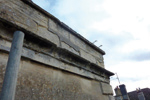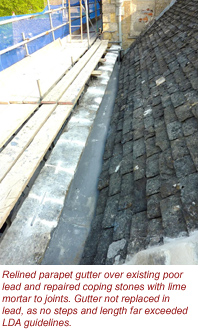The advantages of being accredited
 by M C HALL FRICS IHBC Pg Dip Cons: Historic Buildings. RICS Accredited.
by M C HALL FRICS IHBC Pg Dip Cons: Historic Buildings. RICS Accredited.
After lobbying by a group of forward thinking surveyors, accreditation was introduced for chartered surveyors as well as architects. Surveyors have now been recognised by the ecclesiastical bodies in England for about 20 years.
Being accredited enables surveyors to compete with architects for heritage works on churches and to carry out quinquennial inspections.
The Heritage Lottery Fund recognises that these specialists are necessary to support applications for funding where works are being undertaken to listed buildings or ancient monuments.
What advantage is there in accreditation for the secular sector where the prospective or current owner of a listed building seeks to engage a surveyor for advice on property or building works? I suppose the easy answer is that this recognition fits all circumstances. It ensures that the necessarily qualified surveyor has a good working knowledge of conservation issues and has a tried and tested knowledge of the constructional techniques found in old and listed buildings together with the current methods of repair and conservation.
I suppose the easy answer is that this recognition fits all circumstances. It ensures that the necessarily qualified surveyor has a good working knowledge of conservation issues and has a tried and tested knowledge of the constructional techniques found in old and listed buildings together with the current methods of repair and conservation.
With the general economic situation hitting the construction industry particularly hard, many contractors and surveyors are looking to the heritage and conservation sector to fill the shortfall in their usual line of work.
Accreditation ensures there is a good level of skill and expertise and that the surveyor has been vetted by a group of his peers. He will have demonstrated a level of skill in a number of conservation projects to prove he can give clients the correct advice when purchasing property. The right advice at the outset of any building project is vital.
Clients generally just want to know whether a house is in good order. A typical project starts with a pre-purchase survey or an owner asking for advice on maintenance issues. Damp, in all its forms, is the enemy of any property but especially old and listed buildings because they are not built in the same way as modern ones. Some would say modern houses won’t stay the test of time – a different matter!
A typical issue concerns parapet walls. Many of the Cotswold houses I see are 16c or 17c buildings which were gentrified with new facades by the Georgians in the 1760s to 1820s to show off with their newly found wool wealth. Away went the roof gutters and in came upstand parapets with hidden gutters and hidden rainwater pipes. Often these are inaccessible and out of the minds of the owners, and so it is difficult to carry out even simple maintenance. Hidden gutters are often lead lined and, although lead is a very durable material, they often leak after many years of good service. Lead is susceptible to metal fatigue and the gutters crack across their width and then leak - see photographs.
Water then penetrates into the house rather than running down the outside of the wall which would be the case with a gutter. As these walls are built without damp proof courses this causes serious problems. Water therefore has to be stopped at the first line of defence – there is no second line owing to the construction used.
The usual solution is to re-line with lead or to overlay with other materials. Even in listed buildings this is sometimes acceptable where the greater interest is in the preservation of the interior.
At best, water ingress leads to staining of finishes and at worst to outbreaks of brown rot (dry rot), all for the sake of a lack of maintenance.
This is just one example of the special issues facing historic buildings which require in – depth knowledge of all the issues and the best ways to rectify the situation.
• Visit www.hallandensom.co.uk













